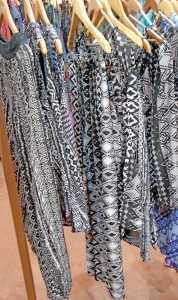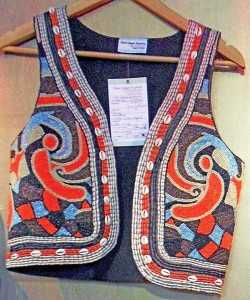
Sidelining the basic minimalistic look, exporters are making a conscious effort of producing value-added products in line with buyers’ requirements, with wide varieties of prints, embroideries and weaving techniques being incorporated in collections for upcoming seasons. Prints, standing out in every aspect, amalgamated with thread, stone and other embroidery techniques, put forth an array of surface ornamentation with an experimental touch. Sequin and bead embroideries sprinkled all-over in varied textures and patterns on cocktail dresses, jackets and blouses, emerge as value-add essentials for A/W’14-15, with high possibility of continuing to S/S’15 collections as well.
Surface ornamentation has always been India’s strength and with the global fashion scene looking for eye-catchers, product development teams are busy mixing and matching techniques for that one exclusive ‘look’ that creates the wow factor. With majority of exporters using Indian embroideries and techniques to bring newness in product development, some industry players are also making the most of hand techniques and technology to create something different to offer to the buyers. The five techniques that rule the coming season from the Indian platform are – thread and cord embroidery, prints, sparkle, fabric manipulation and washes.

Thread and cord embroidery
Started with what was only a technique to be carried out by hand, thread embroidery is drawing attention in many designs and patterns. Manipulated in numerous techniques like phulkari, aari and cord embroidery, and incorporated with prints and patchwork, thread embroidery is being included as surface ornamentation in all silhouettes possible. Rajesh Kumat, Director, Ganga, assenting to the growing popularity of thread embroidery says, “We are working for our S/S’15 collection comprising of thread embroidery and needlework on ladies tops, tunics and skirts. There is big demand for thread embroidery in the market, especially in USA. Colourful hand embroidery, aari and dori embroidery, cording in different patterns are in huge demand.”
Corroborating with that, Rachit Poddar, Director, Cheer Sagar Exports states, “We use a lot of aari work in our bags, jackets and shorts. We have worked with Indian look for some of our collection in traditional Rajasthani embroidery. So we are basically trying to merge the trends with Indian bright colours and threads.” Amongst the techniques, aari embroidery has definitely emerged as the front-runner. Dresses with aari embroidery done on machine with ombre dyed yarn are being created, which gives an illusion of a print from a distance. A mix of dori and cord embroidery on dresses, forming twisted patterns is also being produced but aari embroidery is definitely the favourite embroidery stitch this season.
Prints with a twist
From graphic and geometric to tribal and tessellated, prints in all designs and patterns are being incorporated in the collections. Harish of Lila Shyam Exports says, “For A/W’14-15 and S/S’15, our collections are majorly concentrating on prints. More than 98% of our clothing is developed in prints. Ranging from Tribal, geometric and abstract to oriental, paisley and floral, we have the widest range of prints possible. And out of all, tribal and paisley prints are mostly in demand.”
Technology playing a major role in Value addition
Sanjay, Director, Rekognation
Our collection comprises of short dresses going up to gowns and we cater to bridal market as well. As we majorly target the luxury segment, therefore our main buyers are fashion boutiques and not departmental stores like Zara, Mango. The styles we produce are unique in their own way and cannot be replicated by anyone else. Every technique and every dress is completely machine made; we have created dresses entirely made out of tapes and cords, combined with sequin or bead embroidery. We have specially designed a machine in-house to achieve different and unique value additions. There are multi-head machines available in the market, but, I have got the machinery changed, and replaced the existing embroidery heads with 6 different heads giving me 6 different outputs. There are 6 different techniques we use through this machine – cord work, taping, sequins, thread work, boring/laser and normal embroidery. Therefore, you can get all the 6 techniques done simultaneous on the same garment in different patterns.
Prints have been continuing for some seasons now, but exporters are now combining prints with kantha stitches and hand beading, to create a different look altogether. “There is no certainty about the prints today; to make your product different, you have to develop your own designs, mixing embellishments and other techniques. We are developing styles with patching 2-3 different prints together, mixing embroidery with different prints. Porcelain inspired prints in blue and white, are also gaining popularity,” informs Uday Sehgal, Director, Mariko.

Be it digital, rotary, screen or block, all mediums are being used to create different effects, and amongst all, digital and rotary are appearing to be the front runners. Panels are being block-printed and highlighted by thread embroidery; digitally printed background is being decorated with beading. “Within our company we have 11 brands, so we work on 11 different collections for every season. Therefore, we explore in prints to a large extent on different themes for our collections. I use screen and block print the most. We use all traditional techniques and come out with a contemporary version of it. We don’t use the basic printed fabric directly to make a garment; we print, embroider, attach beading and give different washes as well,” states, Tushar, Head Designer, Tushar Group.
The world of sparkle
Shimmer and sparkle is one of the most directed themes this year, with embellished and ornamented garments to be seen in every collection, “We are primarily into beaded and embellished evening wear. Beads, stones, sequins are put together in Aztec, tribal, geometric and many abstract patterns. Big sized circular sequins combined with beads are scattered all over on skirts and cocktail dresses to give a very high-fashion look,” says, Uneet Chhabra, Director, U & I Exports.
The similar embellishment with a twist can be seen in the recent A/W’14-15 and Christmas collections of Arvind Kumar and Co. They have mixed sequin and thread to create a fur-like texture. Fabrics like satin, polyesters are manipulated with hand, thread, sequin and mix embroidery. “If we develop a print, we like to add some glamour and glitter to it by doing embroideries, mirrors and beads. We use neutral colours and do the embellishments in brighter tones. For the latest collection of A/W, we used velvet, with different kinds of stones with semi-precious look and beadwork,” says Rachit of Arvind Kumar.
Fabric manipulation
Creativity has no boundaries, and now fabric manipulation is not restricted only to pin-tucks, knife pleats and ruffles. With fabrics like rayon, modal blends, nylons and cotton voiles becoming popular, positioning wool and flannel as secondary fabric choices, the art of manipulating fabric in endless possibilities is getting every exporter’s attention. Agreeing with that, Rajesh of Ganga Exports adds, “We experiment a lot with fabric manipulation to go with the thread embroidery. We are doing shirring, ruching and gathering with elastic stitching for waistbands and all-over smocking on dresses and tops. Keeping the conventional knife pleat aside, we also explore block/inverted block pleats, sun pleats, and undulated pleats and tucks a lot.”
Working with variety of fabrics and trims and putting them together to create textures and interesting value additions, Namrata Duggal, Director, Kokeva Designs shares, “We are working with our S/S’15 collection, which includes a range of evening and occasion wear. In value addition, we do different trim and fabric manipulations to make our styles different. Zippers and cords are stitched in various design patterns, strips of box pleated ribbons, tucked from the middle and ruffles are put on neckline as value adds. We also do smocking, shirring and gathering on the waistbands and bust part of dresses and yokes and sleeve hems of tops and tunics.”Owing to the growing trend of fabric manipulation, Mariko also has come out with a collection of dresses, tops, skirts and shirts for S/S’15, developed entirely out of heat-set pleated fabrics.
Dyeing and washing
Tie and Dye, blotching and washing are also an area being widely explored in this season. Fabric is being stitched in abstract patterns and then given different washes to achieve striped, swirl or marbling effects. Tie and dye and batik prints are being contemporised by replacing the traditional bright colours by pastels. Namrata, whose company is specialising in garment washes for 18 years now, shares her recent developments, “For S/S’15 we are developing embroidered washes, which we are planning to showcase in a fashion show in July fair. We are planning to achieve various kinds of effects, like ombre and tie-dye through the washed thread. It is going to have a completely different look as compared the normal garment washes, where thread is going to play a major role, be it through stitching, embroidery or tying. The experiment is on, how practical it is in production that is the main thing to be seen.”

Post a Comment